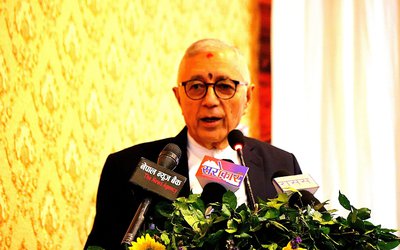Recently the government formed committee led by former Secretary has submitted the report for strengthening the Nepal’s economy . Nepal's economy is projected to grow by 4.4 percent in fiscal year 2025 (i.e. 2081/82), up from an estimated 3.9 percent in fiscal year 2024, according to the Asian Development Bank's (ADB) flagship publication, Asian Development Outlook (ADO) April 2025.
“Nepal's improved growth outlook is being supported by a gradual recovery in domestic demand, private sector reforms, and a further revival of tourism and related services,” said ADB's country director for Nepal.
“Major economic sectors such as manufacturing and construction, which contracted in FY2024, will expand this fiscal year on the back of stable oil and raw material prices, increased liquidity and falling interest rates, which have paved the way for credit growth across all production sectors. Improvements in capital budget implementation, progress in tourism and related services, increased agricultural productivity through mechanization and improved irrigation systems, and government reforms to address the adverse effects of a favorable monsoon are projected to drive gross domestic product (GDP) growth to 5.1 percent in FY2026.
Inflation is expected to remain within the central bank’s upper limit, with normal harvests and a modest decline in inflation in India being the main sources of imports. Nepal’s external sector has stabilized in FY2024, driven by high foreign exchange reserves and a tight monetary stance.
However, the domestic situation has not been as encouraging. Trade uncertainty in Asia and the Pacific, including the US’s public and imposed tariffs, geopolitical tensions, and other factors are likely to weigh on economic growth.
The report states that the impact on inflation will be significant.The ADB report also states that the new tariffs imposed by the US have created trade uncertainty around the world. Analyzing the regional impact of the US tariffs, the ADB estimates that economic growth in the Asia and Pacific region will shrink to 4.9 percent in 2025 and 4.7 percent in 2026. In the case of Nepal, where the door to more exports has been opened due to the 10 percent increase, the government is aware of this and has come up with a proactive and concrete plan.
It is not enough to just sit around and wait for the NITS to be implemented and the World Trade Organization to complain.
In addition, inflation in the region is projected to decrease to 2.3 percent in 2025 and 2.2 percent in 2026. Although expansionary fiscal policies are expected to increase inflation.
The ADB estimates that the risks will increase due to supply chain disruptions due to tensions in the Middle East, rising food and energy prices, global economic uncertainty, and the problems created by the Ukraine-Russia war. Why do we need economic growth?
What is wrong with keeping our economies the same size year after year?The basic answer is: Why do we need economic growth?Economies cannot remain stagnant.
They can either go up or they can go down.A stagnant pool of water starts to stink at some point.Stagnation eventually leads to economic decline. People like progress.
Lack of change makes people frustrated.Economic growth encourages young people. A stagnant economy offers few opportunities for young people. Thus, young people grow old without working in high-skill jobs.
As they grow old, neither they nor their children will have the skills/know-how/ability to compete with the rest of the world. As businesses grow, they need to hire people to do the work.Every person contributes to economic growth.
Why does an economy want economic growth?Because people have hopes and dreams. Rising inflation Events in other countries have also shown that if inflation continues to rise, it can lead to a state of rebellion in society.Ordinary citizens tend to rebel when they find it difficult to live their daily lives due to unnatural price increases.
To prevent such an uncomfortable situation, it is necessary to keep the market healthy and balanced and prevent excessive price increases. In any country, price increases affect the entire supply chain and will increase the inflation of all consumer goods and reduce purchasing power, which makes it more difficult for the poor to buy their food.
. Two-thirds of the total capital needed by the economy is invested by the private sector.Currently, the need for the private sector to be active has been felt.As the country's young generation is leaving, the middle class has fled.The exodus of the middle class has started to shrink domestic consumption.
The current situation is very difficult.But we must try to get out of this difficult situation.Aggressive policy reforms are needed to turn the current despair into hope.
In addition, the transition to federalism provides an opportunity for provincial and local governments to ensure that government funds are used transparently and effectively to deliver public goods and create local initiatives to drive economic growth.
Public participation in local governance mechanisms should ensure this. Economic growth is not possible at the individual level, but if many do it, it will have some positive results.The following are ways to boost the economy:
Economic growth is not possible on an individual level, but if many do, it will have some positive results. Here are some ways to boost the economy: Small businesses are a major source of job creation and innovation, and supporting them can help drive economic growth. Inflation control: Inflation must be managed to ensure stable prices and a stable economy. Inflation can reduce the value of money, making it difficult for businesses to invest and for consumers to spend, which can slow economic growth.
Encourage sustainable practices: Encourage businesses to adopt sustainable practices that help protect the environment, conserve resources, and reduce costs. This can include initiatives such as promoting renewable energy, encouraging recycling, and reducing waste.
Supporting local businesses:
Encourage consumers to shop locally by promoting local businesses through initiatives such as buy-local campaigns, and by providing incentives for local businesses to stay and grow in the area. This can help create a sense of community, promote entrepreneurship, and help put money to good use in the local economy.
Providing access to finance:
Provide access to finance for small businesses and entrepreneurs who may have difficulty obtaining traditional financing. This can include initiatives such as microfinance, crowdfunding, or grants and loans for specific projects or industries.
Developing human capital:
Invest in developing human capital by providing training and education opportunities for people who have fallen behind in the traditional education system. This can include vocational training, apprenticeships, and programs that help develop skills in areas such as technical and entrepreneurial skills.
Encouraging telecommuting:
Telecommuting and remote work should also be encouraged to help reduce traffic congestion, lower transportation costs, and improve work-life balance for employees. This can help increase productivity, reduce overhead costs for businesses, and promote more sustainable ways of working.
Supporting community development:
Invest in community development initiatives such as affordable housing, public transportation, and community centers that provide resources and services to residents. This can help promote social cohesion, reduce poverty, and create opportunities for residents to participate in the local economy.
Developing human capital:
It is also important to invest in human capital development by providing training and education opportunities to those who have fallen behind in the traditional education system. This can include vocational training, apprenticeships, and programs that help develop skills in areas such as technology and entrepreneurship.
Encouraging entrepreneurship, investing in infrastructure, developing a skilled workforce, streamlining regulations, promoting international trade, investing in research and development, and encouraging foreign investment can all contribute to sustainable economic growth. By implementing these strategies, a more dynamic, competitive, and prosperous economy can be created.
Boosting morale:
A key task In this context, the private sector has a primary role to play in improving the economy by boosting the morale of the private sector. The confidence of the general public has decreased, while the morale of businessmen has been lost.
This problem has arisen because both the government and the private sector have not been able to increase investment. Nepal is also fortunate because it has a large number of foreign workers who provide remittances. In recent times, the impact of inflation on the Nepalese market has increased uncontrollably. Since the beginning of the current fiscal year, it seems that inflation has gone beyond the control of the government. Although inflation is a natural process, an unnatural increase is not appropriate in any sense.
- “Kolahalko Kolaj “: A Collection Of Scattered Memories By Prakash Sayami
- Apr 02, 2025
- Nepal-India Trade, Transit And Unauthorized Trade: Some Considerations
- Jan 16, 2025
- PM Oli’s Forthcoming Visit To China: Will The Achievement Be Complete?
- Nov 29, 2024
- Obituary To Dr. Mohan Man Sainju!
- Nov 02, 2024
- Donations To Political Parties: Some Reflections
- Oct 24, 2024















